2007 Bmw 328i Sedan Horsepower
BMW 3-series 2006-2011: N52 vs N54 engines, problems, pros and cons
Updated: February 01, 2020
Not many cars can match the style and driving experience of the BMW 3-series. It's a small sporty car with a strong engine riding on a classic rear-wheel drive platform. The fifth-generation 3-series comes as a rear- or all-wheel drive sedan (E90), wagon (E92), coupe (E92) or a rear-wheel drive-only convertible (E93).
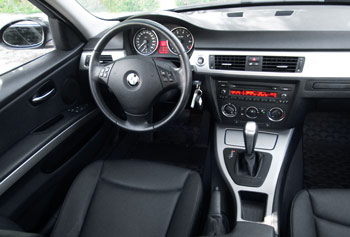 2007 BMW 3-series interior.
2007 BMW 3-series interior.
All body styles are available with a manual transmission. The 3-series interior is sporty-tight and nicely-finished. Front seats are very comfortable on long trips. Crash-test ratings are pretty good. Overall, it's a well-built car, but ownership costs could be expensive. Is this a good reason to pass on this ultimate driving machine? Which engine is more reliable? Let's look closely.
Model line-up: For the 2006 model year, the U.S. 3-series line-up consisted of the 325i and performance-oriented 330i sedan and wagon; the coupe and the convertible carried over from the previous generation (E46). For 2007, the 325i and 330i were replaced by 328i and twin-turbo 335i and a fifth-generation coupe and convertible were added. The 335d turbo-diesel was added for 2009. Read also: Pros and cons of buying a car with a Turbocharger.
N52 Engine: The North-American 323 (Canada only), 325, 328 and 330 models come with the N52 inline-6 DOHC engine. The Canadian 323i has the 2.5L version (N52B25), while the 325i, 328i and 330i models come with different versions of the 3.0L N52B30 engine (UL, M1 and OL respectively).
The N52 is a lightweight high-tech motor with 4 valves per cylinder, variable intake valve lift and variable timing. Its aluminum cylinder block is incased into a magnesium shell. It comes with hollow camshafts and an electric water pump. This engine has a maintenance-free timing chain; there is no timing belt. Overall it's a solid performer.
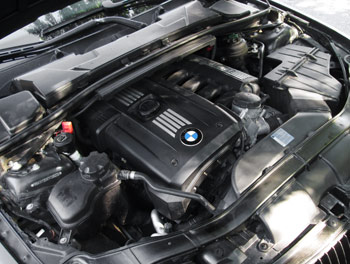 2007 BMW 3-series inline-6 N52 engine.
2007 BMW 3-series inline-6 N52 engine.
The difference in horsepower between models is achieved by different compression ratio, intake manifold design and computer tuning. The 2006 BMW 325i (215 hp) and the 2007-2011 BMW 328i (230 hp) have a single-stage intake, while the 2006 BMW 330i (255 hp) comes a the 3-stage DISA intake manifold. Does this mean that you can add more power to 325i or 328i by upgrading to a 3-stage intake and re-flashing the engine computer? Read more below.
N54 Engine: The 306-hp 3.0L direct-injected inline-6 DOHC N54 powers the high-performance BMW 335i for 2007-2010 model years.
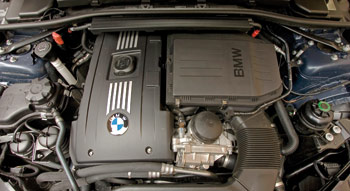 BMW N54 twin-turbo engine. Photo: BMW
BMW N54 twin-turbo engine. Photo: BMW
The N54 has a pair of small low-boost (8.8 psi) turbocharges, each powered by three cylinders (123 and 456).
Fuel is injected directly into cylinders by high-pressure piezo fuel injectors. Due to its complex design, the N54 could be expensive to maintain when out of warranty, but it has a lot more power. The stock 335i can accelerate from 0 to 60 mph in around 5 seconds. Read also: Pros and cons of buying a car with Direct Injection.
Fuel Economy: The diesel-powered 335d is very fuel-efficient (36 mpg or 6.5 L/100 km on the highway for the 2009, 2010 model) and can get up to 435 miles to a tank, however, it's rare on the used car market. The two most common U.S. models, the 328i and 335i (2010 model year) get 18/28 and 17/26 mpg city/highway respectively on premium gasoline.
Problems: The electronic steering lock is one of the trouble areas mostly in the 2006 and some 2007 models. Initially the yellow or red steering lock warning light might come on and the steering lock can take some time to unlock intermittently. Eventually, the lock mechanism may fail completely, preventing the car from starting. BMW's recommended repair involves replacement of the steering column, which could be costly ($1,200-$1,500). Plenty of repair information is available online. Some owners reported that reprogramming solved the issue. Try googling ELV E90 repair.
Faulty exhaust-side hydraulic valve lifters (HVA) can cause a ticking noise after the engine is warmed up in some 2006-2008 models with the N52 engine. Some owners reported the noise temporarily disappeared after a long highway drive or switching to a different type of engine oil. As per one of the BMW service bulletins (SIB), the 12 exhaust side lifters must be replaced with updated parts ($1,200-$2,000 repair). In some cases the cylinder head also had to be replaced to completely resolve the problem. This post provides some more info. Some owners choose to live with the problem rather than spend money on repairs.
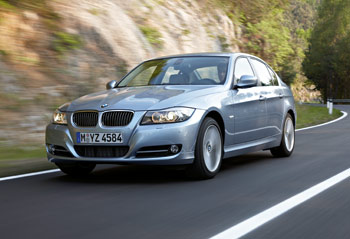 2009 BMW 3-series sedan. Photo: BMW
2009 BMW 3-series sedan. Photo: BMW
A failed electric water pump can cause overheating. Another symptom could be the radiator fan staying on at high speed for a long time. This repair should be done as soon as possible, as overheating can cause more engine problems down the road. Usually a thermostat is recommended to be replaced along with the water pump. The repair could cost from $800 for a water pump only to $1200-$1800 with the thermostat.
Oil leaks are very common. The most often reported source is the valve cover gasket ($550-700), and the oil filter housing gasket ($370-$600). Transmission pan and the connector sleeve may leak too.
A failed ignition coil may cause the engine to misfire and run rough. Ignition coil replacement is not very expensive. If the spark plugs haven't been replaced in a while, it might be a good idea to replace the spark plugs too.
In the N54 engine, the high pressure fuel pump is a commonly mentioned problem. Symptoms include long starting time (long crank), reduced engine power and Service Engine Soon light. However, there was a recall in 2010 and according to some sources, the warranty has been extended. Read this post. This page on BMW USA website allows you to check for recalls. Issues with turbochargers and wastegates are mentioned frequently.
Sticky door handles are often mentioned. Some owners report that sticky door handles can be resolved by lubricating them. Watch this video.
A failing blower fan motor can produce a squeaking noise. Some owners were able to get rid of the problem by lubricating the motor bearings, but in many cases the heater fan motor had to be replaced ($550-650). It's not a very difficult job. Here is the thread at E90post.com
A blown fuse can cause the power lock function to stop working, although in many cases, it could be caused by a failing door lock actuator that will need to be replaced. See also: How to test a fuse in a car. Read this thread for more info.
Other issues include faulty VANOS solenoids, leaking headlight washer jets, cracked rubber cooling system hoses and suspension bushings, faulty window regulators.
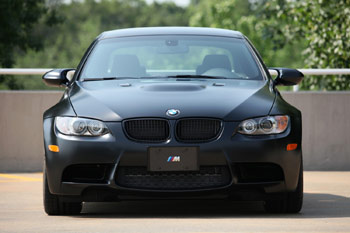 2011 BMW Frozen Black Edition M3 Coupe. One of only 20 sold in the U.S. Photo: BMW.
2011 BMW Frozen Black Edition M3 Coupe. One of only 20 sold in the U.S. Photo: BMW.
BMW M3: For the 2006, the E46 M3 carried over. The 4-th generation E9x M3 became available for 2008, as a sedan, coupe or convertible. The M3 has rear-wheel drive and comes with a naturally-aspirated 414-hp 4.0L V8 S65 engine. The 0 to 60 mph time is around 4.5 seconds. The M3 comes with a 6-speed manual or 7-speed dual clutch automatic transmission.
It might be difficult to find a used M3 in an "old-lady-driven" condition and it won't be cheap: at the time we did our research for this review, the average price in the U.S. for a 5-year old M3 was around $39,000.
How well does the used 3-series BMW hold its value?
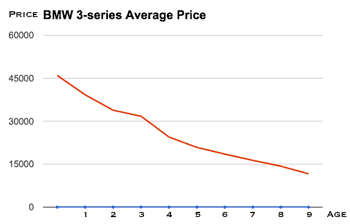 BMW depreciation chart
BMW depreciation chart
We have researched U.S. prices and it looks like the biggest drop in the value of the 3-series BMW happens in the first four years of ownership (see the chart). This means that you will lose less money in depreciation if you buy a 4-5 year old or older Bimmer. While the new BMW 3-series MSRP is in the $40,000-50,000 range, an average retail price for a 9-year old used vehicle is around $11,600.
Pros: Styling, excellent handling, comfortable ride, strong engine, rich interior, condition-based maintenance remainder, variety of available mods and enthusiast support, plenty of owner forums and do-it-yourself information.
Cons: Requires premium gasoline, expensive to maintain, potentially-costly problems, tight interior space, run-flat tires, no spare tire.
Overall: It's no secret that a used BMW will be more expensive to maintain than a Honda or Toyota, which means you have to have spare cash available. Buying an aftermarket extended warranty with good coverage is an option. The twin-turbo 335i will need more expensive repairs in the long run, while the 2009-plus 328i is a more sensible choice. As of February 2020 Consumer Reports rates the 2006-2011 3-series poorly for reliability, mostly for engine and cooling system problems. A repair shop that specializes in BMW is your best option for servicing. If you like working on your car, finding DIY information won't be a problem, thanks to many BMW enthusiasts.
Overall, the 3-series is an excellent car to drive. If you know what to expect and are ready to deal with potentially expensive repairs, there is no other reason why they should be overlooked. We strongly recommend having the vehicle inspected by an independent dealer or BMW specialist before purchase. After an inspection, ask a mechanic what problems to expect in the future.
Related reviews:
Honda Accord 2008-2012 review
Used Toyota Camry 2007-2011 review
Used Mazda 6 2009-2013 review
Acura TL 2004-2008 review
What to look for when buying a used BMW 3-series: Check the service history if available. Has the steering column already been replaced? Any repairs to hydraulic valve lifters? Were the oil changes done regularly? Has the car been severely overheated? Avoid if yes. When inspecting the car on the lot: Any signs of an accident repairs? Do all the door handles, locks, windows, wipers work? Any warning lights? Any warning light has to be properly diagnosed and repaired before purchase, not just reset.
Is there burnt oil smell in the engine compartment (this is usually a sign of oil leaks).
During a test-drive: In the N52, the ticking noise at idle could be caused by a faulty lifter. In the N54, watch out for noisy turbochargers and wastegate rattles. There are several YouTube videos that demonstrate various types of noises. Test the manual shift mode of the automatic transmission, some owners report a problem with the tranny that prevents it from going into manual shift. Read more: Signs of problems to watch out for when test driving a used car.
Before buying, have the car inspected by an independent BMW specialist or a dealer.
3-stage intake upgrade for the 325/328: This thread at E90Post provides a summary. This post describes the upgrade process and the results. This upgrade won't be cheap, but the results are interesting.
Run-flat tires vs conventional: The advantage of the Run-Flat tires is that they can be driven temporarily at limited speed even without pressure. However, cars equipped with run-flat tires have no spare tire. There is an ongoing debate on run-flat vs. conventional tires, with many BMW owners complaining about the rough and noisy ride and replacement cost of run-flats. Some owners chose to switch to conventional tires. This post describes a clever way to store the spare tire and the jack in the trunk. The run-flat tires can be recognized by a snail-like symbol.
Maintenance: According to the 2008 3-series owner's manual, the 3-series requires High Performance Synthetic Oil; 5W-30 or 5W-40, depending on climatic conditions. BMW doesn't specify oil change intervals; instead, the Condition Based Service (CBS) shows current and future maintenance requirements on the Service Interval Display. There is a disagreement about whether to stick to CBS oil change intervals (around 15,000 miles for E90) or have the oil changes done more often. Some owners prefer changing oil at 7,500-10,000 miles, which seems more reasonable at higher mileage, especially considering that 2014 and newer BMW switched to 10,000-mile CBS intervals. In the N54 as in any turbocharged engine, oil is subjected to higher temperatures and degrades even faster.
BMW engines are known for oil consumption, which means the oil may need to be topped up once in a while. For this reason, it might be a good idea to keep a spare bottle of engine oil in the car.
BMW USA Owners - download an electronic copy of the owner's manual and check for safety recalls (VIN - number required)
BMW Service and Warranty Books - download Service and Warranty Guide. It includes maintenance requirements for items not covered in CBS (spark plugs, oxygen sensor, automatic transmission fluid, etc.).
2007 Bmw 328i Sedan Horsepower
Source: https://www.samarins.com/reviews/bmw-3-series.html
